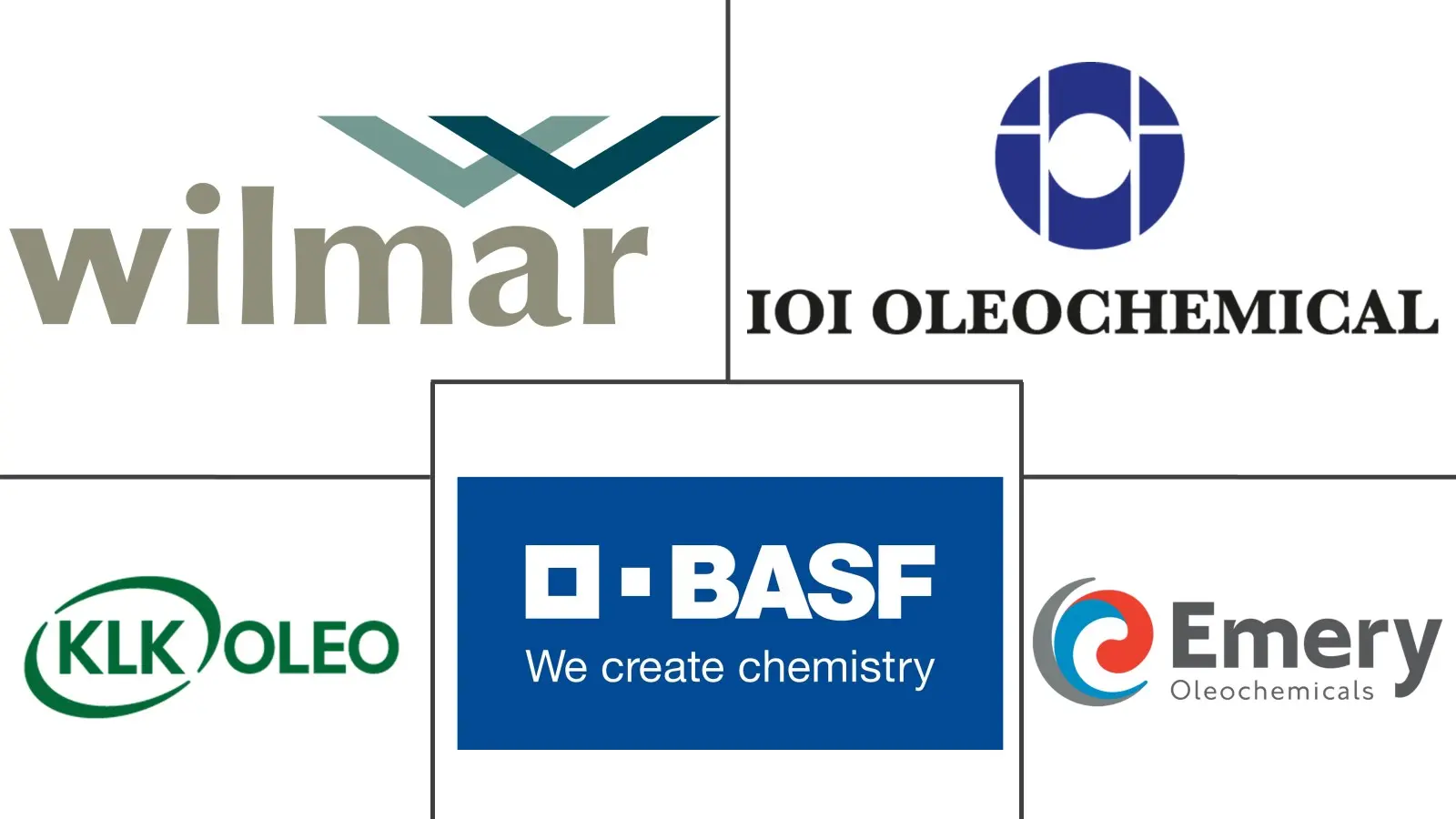Oleochemicals Market Size and Share
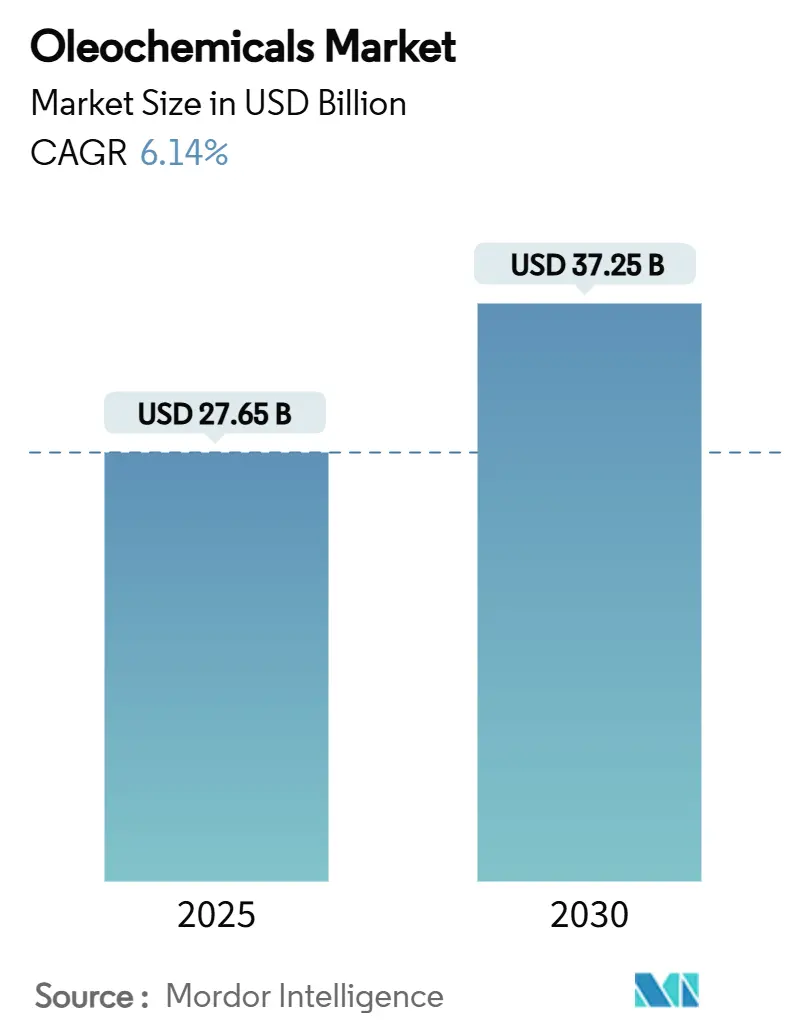
Oleochemicals Market Analysis by Mordor Intelligence
The Oleochemicals Market size is estimated at USD 27.65 Billion in 2025, and is expected to reach USD 37.25 Billion by 2030, at a CAGR of 6.14% during the forecast period (2025-2030). Current expansion reflects policy-driven demand for bio-based surfactants, biodiesel blending mandates, and accelerating consumer preference for natural ingredients across home and personal care applications. Indonesia’s B40 program alone redirects more than 15 Million kilolitres of palm-based methyl esters into energy use, tightening supply for conventional chemical uses. Concurrently, the European Union (EU) Deforestation Regulation raises compliance costs and spurs investment in traceable, certified supply chains. Synthetic-biology routes that convert sugars or methanol into fatty acids and alcohols are emerging, promising feedstock diversification and lower land-use impacts. Asia-Pacific remains the focus of production and demand, supported by integrated palm infrastructure and fast-growing personal-care consumption in China and Southeast Asia.
Key Report Takeaways
- By product type, fatty acids led with 38.21% of the Oleochemicals market share in 2024, while methyl esters are projected to grow at a 7.82% CAGR through 2030.
- By feedstock source, vegetable oils commanded 64.56% share of the Oleochemicals market size in 2024 and is also expected to grow with the fastest CAGR of 6.78% to 2030.
- By end-user industry, soap and detergent accounted for 32.43% share of the Oleochemicals market size in 2024, whereas personal care and cosmetics is advancing at a 7.67% CAGR through 2030.
- By geography, Asia-Pacific captured 47.58% of the Oleochemicals market share in 2024, and is expected to grow with a CAGR of 8.06% to 2030.
Global Oleochemicals Market Trends and Insights
Drivers Impact Analysis
| Driver | (~) % Impact on CAGR Forecast | Geographic Relevance | Impact Timeline |
|---|---|---|---|
| Growing Surfactants Capacity in Asia-pacific | +1.8% | APAC core, global spill-over | Medium term (2-4 years) |
| Expanding Personal-care and Cosmetics Demand | +1.5% | Global, strongest in North America & EU | Long term (≥ 4 years) |
| Biodiesel Mandates for Fatty Acid Methyl Esters | +1.2% | Indonesia, Brazil, EU | Short term (≤ 2 years) |
| Shift Toward Biodegradable, Plant-based Chemicals | +0.9% | EU & North America, APAC follow | Long term (≥ 4 years) |
| Synthetic-biology Routes to Low-cost Fatty Alcohols | +0.6% | North America & EU innovation hubs | Long term (≥ 4 years) |
| Source: Mordor Intelligence | |||
Growing Surfactants Capacity in Asia-Pacific
Surfactant manufacturing projects in China, Indonesia, and Malaysia are scaling rapidly, lifting baseline demand for C12-C18 fatty acids and alcohols. KLK OLEO’s recent 200 ktpa expansion in Zhangjiagang underscores the region’s feedstock and logistics advantage. Local personal-care brands are moving upmarket, incorporating naturally derived emulsifiers to meet domestic “clean beauty” standards. Export-oriented producers capture cost-sensitive orders from Europe as petro-inflation raises synthetic surfactant prices. Governments are promoting specialty chemicals under value-addition roadmaps, further anchoring new oleochemical units. The cumulative effect is a structural uplift in baseline offtake that cushions the oleochemicals market against cyclical swings.
Expanding Personal-Care and Cosmetics Demand
Global retail skin-care sales rose 9% in 2024, and formulating chemists increasingly specify plant-based emollients, esters, and emulsifiers. BASF’s Verdessence line illustrates how waxy plant polymers replace microplastics without compromising sensory profiles [1]BASF launches Verdessence range, BASF, basf.com. North American consumers rank biodegradability second only to efficacy in purchase drivers, pushing brand owners to reformulate legacy stock keeping unit (SKUs). Asian multinationals mirror this shift, aiming for ECOCERT and COSMOS accreditation on flagship lines. Bio-surfactant commercial trials using rhamnolipids show double-digit growth potential, signalling a medium-term substitution of synthetic ethoxylates. Collectively, premiumisation and sustainability converge to keep price elasticity favourable for specialty oleochemicals.
Biodiesel Mandates for Fatty Acid Methyl Esters
Indonesia’s B40 mandate alone absorbs roughly 28% of the country’s palm output into energy applications. Brazil follows with a legislated rise to B17 by 2027, lifting annual soybean oil demand by 2 Million tons. The EU Renewable Energy Directive maintains momentum, though phased removal of high-ILUC (Indirect Land Use Change) palm drives a pivot to waste-based oils. Refiners value methyl esters for cold-flow improvement, ensuring stable off-take even when fossil diesel prices ease. This locks in volumes for oleochemical suppliers but can squeeze fatty acid availability for soaps, raising spreads between Crude Palm Kernel Oil (CPKO) and lauric derivatives. The mandate schedule, therefore, acts as both a tailwind and a bottleneck within the broader Oleochemicals market.
Shift Toward Biodegradable, Plant-Based Chemicals
The EU Corporate Sustainability Reporting Directive requires disclosure of Scope 3 impacts, prompting formulation switches to bio-based inputs. Household detergent majors now deploy mass-balance certified fatty alcohol ethoxylates, delivering a 20% lower carbon footprint than petroleum equivalents, according to internal Life Cycle Assessment (LCA) filings. Consumer activism has catalysed boycott risks around non-RSPO (Roundtable on Sustainable Palm Oil) palm, accelerating premiums for certified feedstock. Supply chains respond through traceability blockchains and segregated logistics nodes. Demand for biodegradable lubricants in construction and marine segments adds a diversified pull on mid-cut oleochemicals. Regulatory carrot-and-stick mechanisms embed a steady demand escalator within the Oleochemicals market.
Restraints Impact Analysis
| Restraint | (~) % Impact on CAGR Forecast | Geographic Relevance | Impact Timeline |
|---|---|---|---|
| Feedstock Price Volatility | -1.4% | Global, acute in APAC hubs | Short term (≤ 2 years) |
| NGO and Regulatory Pressure on Unsustainable Palm Oil | -0.8% | EU & North America demand, APAC supply | Medium term (2-4 years) |
| Petrochemical Price Competition in Bulk Applications | -0.6% | Global commodity segments | Short term (≤ 2 years) |
| Source: Mordor Intelligence | |||
Feedstock Price Volatility
Crude palm oil futures swung between USD 780 and USD 970 per ton in 2024 following El Niño-linked yield drops, eroding gross margins for splitters and distillers. Coconut oil prices also spiked after typhoon damage to Philippine plantations, pressuring lauric acid derivative costs. North American buyers turned to Brazilian tallow, but a 377% export surge lifted local fat prices by 18%. Producers responded by shortening contract tenors and introducing price-escalation clauses. Persistent volatility complicates inventory planning and can trigger demand destruction when costs overshoot end-use price points.
NGO and Regulatory Pressure on Unsustainable Palm Oil
Implementing the EU Deforestation Regulation in 2025 imposes due diligence obligations, with non-compliant shipments facing rejection at the port of entry [2]“EU deforestation law implications,” European Parliament Briefing, europarl.europa.eu . Transport & Environment’s audit questioning biofuel feedstock declarations heightened scrutiny on palm mill effluent credits. Indonesian and Malaysian concessions scramble to certify additional hectares, yet smallholder inclusion remains a bottleneck. Oleochemical importers incur higher segregation and traceability costs, while reputational risk deters some buyers from palm-based inputs entirely. Feedstock shifts or certification upgrades will mitigate impact in the medium term, but near-term friction persists.
Segment Analysis
By Product Type: Methyl Esters Drive Growth Despite Fatty Acids Dominance
Global fatty acids retained 38.21% Oleochemicals market share in 2024 on the back of solid detergent and personal-care demand. The Oleochemicals market size for methyl esters, however, is projected to rise at a 7.82% CAGR, supported by mandatory biodiesel programs across Indonesia, Brazil, and the EU. Fatty alcohol innovation through fermentation could recalibrate cost curves, yet commercial volumes will remain limited until late decade. Glycerine oversupply from biodiesel yields downward price pressure, encouraging its uptake in pharma and food applications. As policy-driven energy demand is largely price-inelastic, methyl ester offtake continues even during economic slowdowns. Conversely, specialty fatty acid derivatives such as azelaic and sebacic acids enjoy premium streams, benefiting integrated producers able to valorise by-products.
Methyl esters’ rapid growth diverts feedstock away from soap noodles, occasionally forcing price pass-throughs in consumer staples. Market participants thus explore route-to-market synergies: integrated agribusinesses with crushing, biodiesel, and oleochemical assets optimise allocation daily. Fatty alcohol demand intersects with rising sulfate-free cosmetic trends, reinforcing alcohol’s relevance despite ester acceleration. Net effect is a nuanced competitive landscape where product categories no longer operate in silos, but rather interlink through feedstock and coproduct economics within the wider Oleochemicals market.
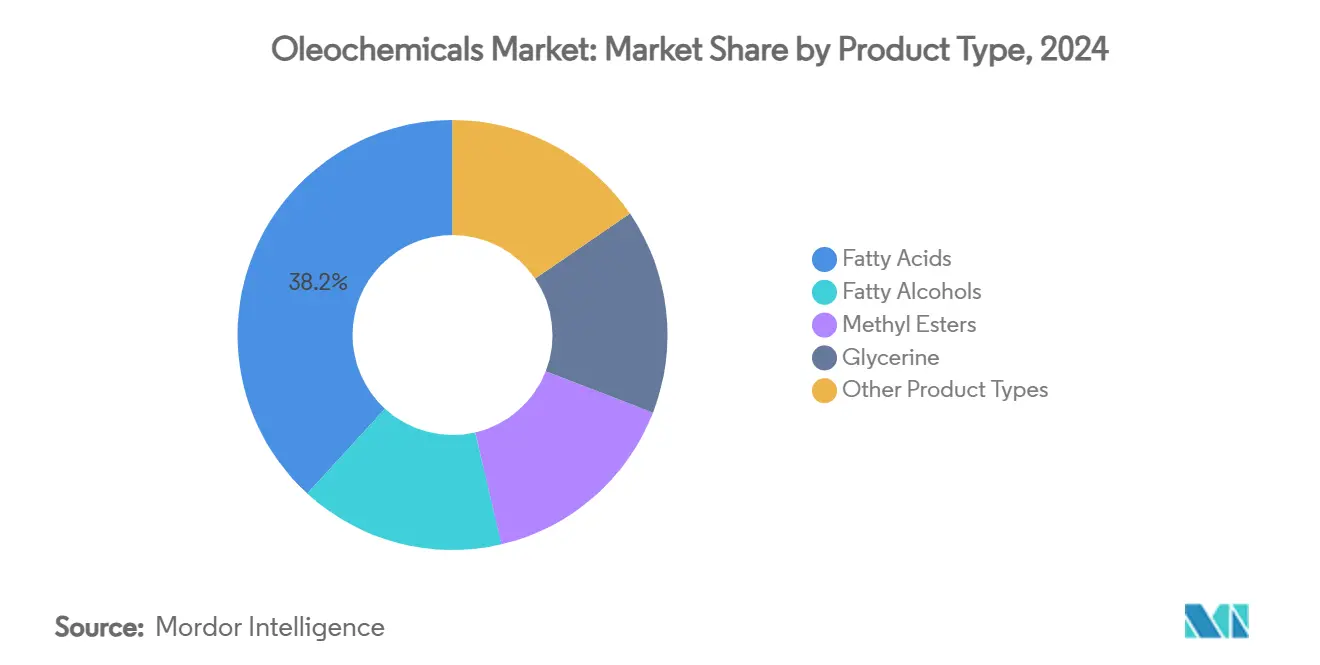
Note: Segment shares of all individual segments available upon report purchase
By Feedstock Source: Vegetable Oils Face Sustainability Scrutiny
Vegetable oils delivered a 64.56% share of Oleochemical feedstock in 2024 and command the largest slice of the Oleochemicals market size, yet they face intense Environmental, Social, and Governance (ESG) scrutiny. Palm oil’s dominant role draws Non-Governmental Organization (NGO) attention, driving premiums for RSPO-segregated grades and stimulating investment in precision-fermented substitutes. Soybean oil in South America increasingly supplies B15-plus biodiesel blends, constraining chemical availability. Animal fats and used cooking oil combined met 37% of the United States' renewable diesel inputs in 2023, proving the scalability of waste streams. For oleochemical makers, multi-feedstock flexibility becomes a competitive necessity, enabling rapid switches based on logistics, certification, and price. Companies without such optionality risk utilisation dips when a single feedstock faces a shock.
Supply diversification extends to algae and yeast oils produced via synthetic biology. Early pilots yield 1-3 ktpa, small relative to global demand, but early-adopter cosmetics brands contract entire volumes at premium prices for marketing differentiation. As fermentation titers improve and capex amortises, share-of-supply could edge upward, further diluting traditional vegetable dominance. Nevertheless, cost-upside means vegetable oils will retain bulk leadership through 2030, with sustainability certification acting as licence-to-operate rather than price differentiator inside the Oleochemicals market.
By End-User Industry: Personal Care Outpaces Traditional Applications
Soap and detergent secured 32.43% of the Oleochemicals market share in 2024, reflecting legacy supply chains and low-price elasticity. The Oleochemicals market size allocated to personal care and cosmetics is set to grow 7.67% annually, propelled by consumer penchant for plant-based ingredients and climate-adaptive skin solutions. Large brand owners pledge net-zero targets, cascading Scope 3 reductions onto suppliers and favouring RSPO-certified and bio-based derivatives. Biosurfactants gain traction, though current costs limit adoption to premium SKU ranges. Pharmaceutical uptake benefits from glycerine abundance, lowering formulation costs for cough syrups and capsule shells. Food and beverage users navigate tighter vegetable oil availability, occasionally substituting with animal fat derivatives when clean-label constraints allow.
Personal-care formulators increasingly adopt multifunctional esters that deliver emolliency and emulsification in one molecule, enabling complexity reduction and label appeal. Oleochemical producers, therefore, market performance benefits, not merely sustainability, defending margins in a value-seeking environment. Bio-based plasticisers and polyols address tightening phthalate regulations in polymers, though price parity remains elusive. The demand mosaic underscores a shift from commodity volume toward specialty applications that align with regulatory and consumer megatrends.
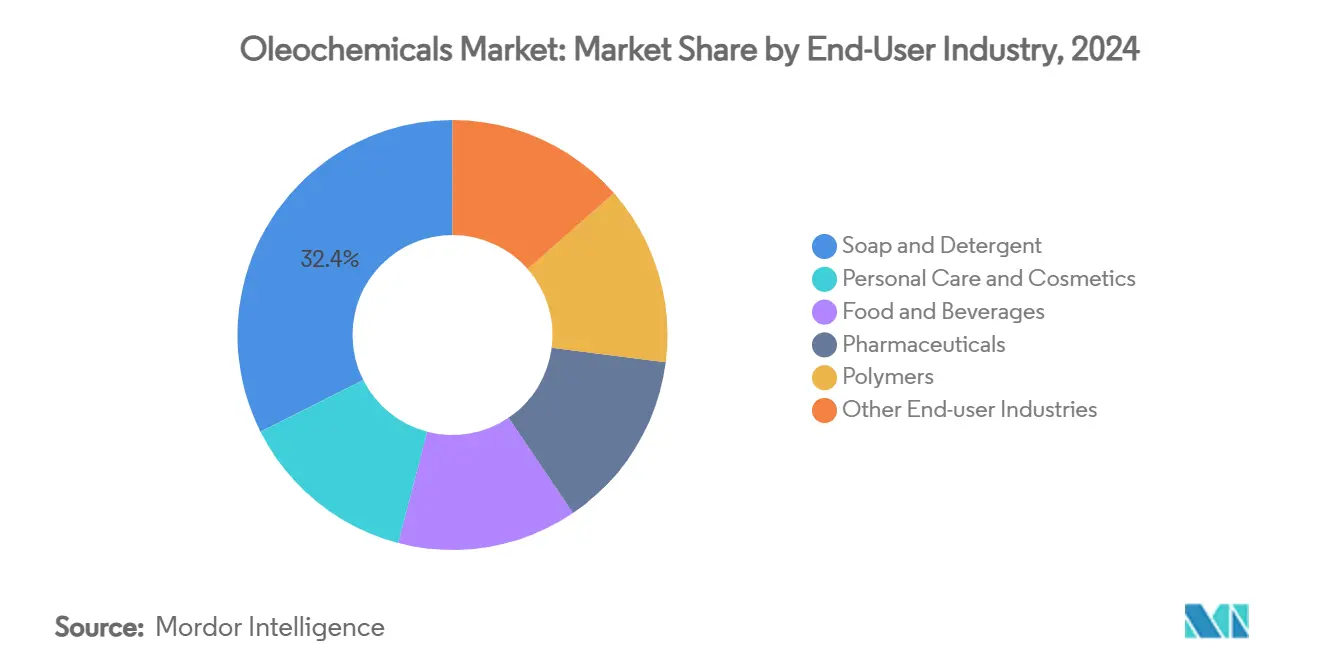
Note: Segment shares of all individual segments available upon report purchase
Geography Analysis
Asia-Pacific held 47.58% Oleochemicals market share in 2024, anchoring the Oleochemicals market courtesy of integrated palm clusters and cost-efficient logistics. Regional CAGR of 8.06% will continue as China’s surfactant complexes ramp up and Southeast Asian disposable incomes climb. Yet export-centric players must meet EU and North American sustainability thresholds or risk margin-eroding discounts. Indonesian biodiesel uptake diverts feedstock and fosters domestic refinery investments that lift local value capture. Malaysia’s specialty chemicals roadmap aims to double downstream revenue by 2030, though skilled-labour shortages could constrain execution. South Asia shows rising demand for soap noodles, but quality specifications still lag the Organization for Economic Cooperation and Development (OECD) markets, tempering price realization.
North America and Europe balance mature consumption with technological innovation. EU policy bans high-ILUC palm, incentivising waste-oil and animal fat-based oleochemicals, while venture-backed fermentation start-ups secure offtake agreements with cosmetic multinationals. US renewable diesel growth sequesters tallows, prompting local oleochemical players to import lauric oils despite freight premiums. South America, led by Brazil, grows fastest after Asia-Pacific (APAC); expanding crush capacity ensures ready soybean oil supply, although domestic biodiesel uptake absorbs a significant slice. Middle East and Africa lag in production capacity but present incremental demand, with Gulf states encouraging bio-lubricant uptake in marine and mining sectors, offering gradual yet stable pull for exporters.

Competitive Landscape
The Oleochemicals market is moderately consolidated with the presence of major players, such as Wilmar International Ltd., KLK OLEO, IOI Oleochemical, Emery Oleochemicals, and BASF. BASF, Wilmar International, and KLK OLEO leverage vertical integration from plantations or basic chemicals to downstream specialties, maintaining cost advantage and feedstock optionality. BASF advances biotechnology through partnerships such as the Acies Bio fatty alcohol venture, augmenting flexibility to meet EU sustainability criteria. Producers bundle technical services on rheology, emulsification, and sensory optimisation, migrating away from commodity tendering. The balance between cost leadership and sustainability credentials thus shapes market standing. Companies failing to invest in traceable systems risk delisting by multinational customers, while over-investment without offtake guarantees can erode returns when price-sensitive buyers resist premiums.
Oleochemicals Industry Leaders
-
IOI Oleochemical
-
Emery Oleochemicals
-
KLK OLEO
-
Wilmar International Ltd.
-
BASF
- *Disclaimer: Major Players sorted in no particular order
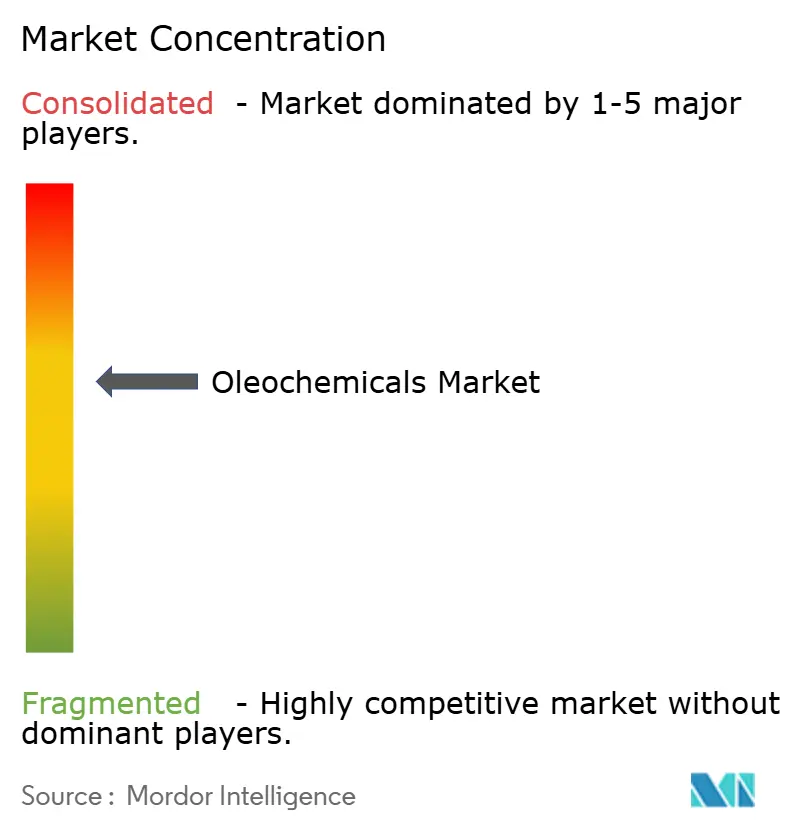
Recent Industry Developments
- January 2024: Godrej Industries Group revealed plans for an INR 600 crore (USD 69.43 million) investment over the next four years to expand its Valia unit in Bharuch, Gujarat. This unit manufactures various oleochemical products sourced from organic materials, serving market segments such as personal care, pharmaceuticals, and food industries.
- June 2023: Oleon NV, a European producer of oleochemicals and part of the Avril Group, inaugurated a new plant in Oelegem. This newly established plant employs enzymatic esterification, a method that produces esters (a type of oleochemical) using natural building blocks like proteins or enzymes.
Global Oleochemicals Market Report Scope
Oleochemicals are chemical compounds derived from natural oils and fats, typically obtained from vegetable sources such as palm, soybean, and coconut, or animal sources like tallow and lard. These chemicals undergo various processes such as hydrolysis, transesterification, or hydrogenation to produce a wide range of products, including fatty acids, glycerin, fatty alcohols, esters, and other derivatives.
The oleochemicals market is segmented by product type, end-user industry, and geography. By product type, the market is segmented into fatty acids, fatty alcohols, methyl esters, glycerine, and other product types. By end-user industry, the market is segmented into cosmetics and personal care, soap and detergents, pharmaceuticals, food and beverages, polymers, and other end-user industries. The report also covers the market size and forecasts for the oleochemicals market in 15 countries across major regions. For each segment, the market sizing and forecasts have been done based on volume (Million Tons).
| Fatty Acids |
| Fatty Alcohols |
| Methyl Esters |
| Glycerine |
| Other Product Types |
| Vegetable Oils |
| Animal Fats |
| Personal Care and Cosmetics |
| Soap and Detergent |
| Food and Beverages |
| Pharmaceuticals |
| Polymers |
| Other End-user Industries |
| Asia-Pacific | China |
| India | |
| Japan | |
| South Korea | |
| ASEAN | |
| Rest of Asia-Pacific | |
| North America | United States |
| Canada | |
| Mexico | |
| Europe | Germany |
| United Kingdom | |
| France | |
| Italy | |
| Rest of Europe | |
| South America | Brazil |
| Argentina | |
| Rest of South America | |
| Middle East and Africa | Saudi Arabia |
| South Africa | |
| Rest of Middle East and Africa |
| Product Type | Fatty Acids | |
| Fatty Alcohols | ||
| Methyl Esters | ||
| Glycerine | ||
| Other Product Types | ||
| Feedstock Source | Vegetable Oils | |
| Animal Fats | ||
| End-user Industry | Personal Care and Cosmetics | |
| Soap and Detergent | ||
| Food and Beverages | ||
| Pharmaceuticals | ||
| Polymers | ||
| Other End-user Industries | ||
| Geography | Asia-Pacific | China |
| India | ||
| Japan | ||
| South Korea | ||
| ASEAN | ||
| Rest of Asia-Pacific | ||
| North America | United States | |
| Canada | ||
| Mexico | ||
| Europe | Germany | |
| United Kingdom | ||
| France | ||
| Italy | ||
| Rest of Europe | ||
| South America | Brazil | |
| Argentina | ||
| Rest of South America | ||
| Middle East and Africa | Saudi Arabia | |
| South Africa | ||
| Rest of Middle East and Africa | ||
Key Questions Answered in the Report
What is the projected growth rate of the Oleochemicals market between 2025 and 2030?
The Oleochemicals market is forecast to grow at a 6.14% CAGR, moving from USD 27.65 Billion in 2025 to USD 37.25 Billion by 2030.
Which product category is expected to register the fastest growth?
Methyl esters are projected to expand at 7.82% CAGR, fuelled by biodiesel blending mandates in Indonesia, Brazil, and the EU.
Why does Asia-Pacific dominate the Oleochemicals market?
Asia-Pacific controls 47.58% of global revenues thanks to integrated palm oil infrastructure, expanding surfactant capacity in China, and rising personal-care demand across Southeast Asia.
How are sustainability regulations affecting supply chains?
The EU Deforestation Regulation imposes strict traceability, prompting producers to invest in certified feedstocks, blockchain tracking, and synthetic-biology alternatives to maintain market access.
What role does synthetic biology play in future oleochemical supply?
Fermentation-based routes to fatty acids and alcohols are advancing toward commercial scale, offering deforestation-free feedstocks and potential cost parity once plants exceed 60 ktpa capacity.
Page last updated on:
